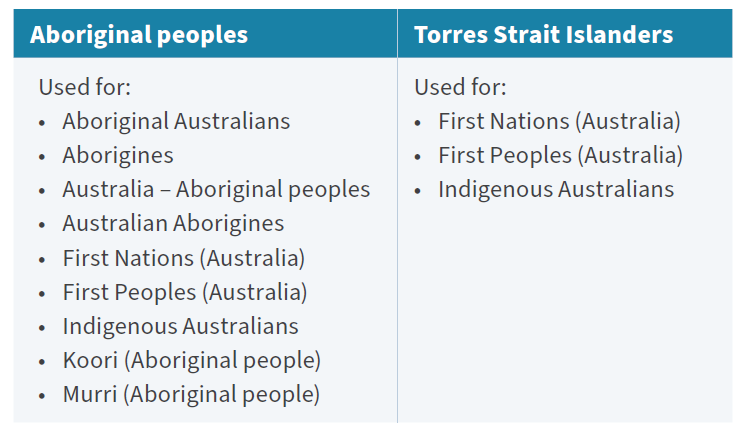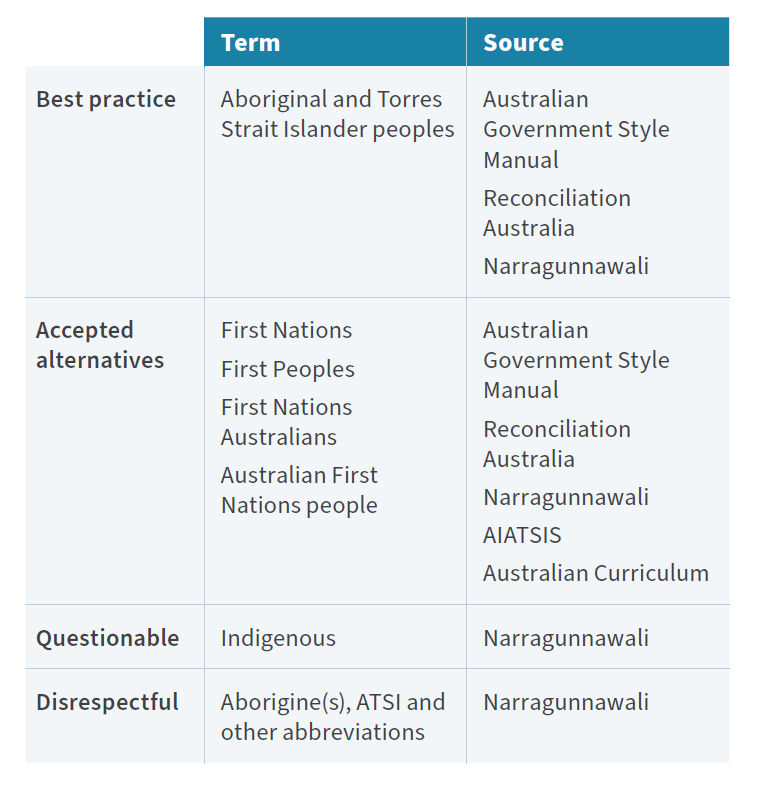Issue 127
Term 4 2023
Respect first: Understanding SCIS Subject Headings for Aboriginal and Torres Strait Islander people
SCIS continually works to enhance its data for diversity and respect. This article covers recent updates to SCIS Data that contribute to this project.

The significance of using respectful language in cataloguing cannot be overstated. The SCIS (Schools Catalogue Information Service) Subject Headings List (SCISSHL) plays a crucial role in shaping the language used to describe catalogue records’ content. Given that educators and students access these records, ensuring the language is respectful and culturally sensitive is essential.
To ensure our database is up to date with the evolving language landscape, SCIS welcomes feedback on improvements to the SCIS subject headings. We also provide guidance on respectful cataloguing terms to those subscribers who contact us. We often receive enquiries about the standard heading SCIS uses to define the First Peoples of Australia, especially as the Australian Curriculum v9 prefers to use the terms ‘First Nations Australians’ and ‘Australian First Nations Peoples’ (Australian Curriculum, 2023). Our cataloguing team is continually working to create headings and reference terms that more respectfully relate to First Nations lands, cultures and peoples. To help you understand how headings related to First Nations Australians currently work in SCIS, we’ve put together a short guide.
Recognising First Peoples: SCIS Subject Headings
SCIS employs two authorised headings to define the First Peoples of Australia, specifically the Aboriginal and Torres Strait Islander communities:
- Aboriginal peoples
- Torres Strait Islanders
These headings are supplemented by various ‘used for’ references that guide users to the appropriate authorised headings while searching (see the table below). These references encompass a range of terms to encapsulate the rich cultural diversity of Australia’s First Nations peoples (See Table 1).
When developing these headings and references, respecting individual preferences for identification has been crucial. However, it is also a complex issue to navigate. Different communities have different ideas and preferences around language. Uncle Allan, a Traditional Owner and Elder of the Yugambeh language group of peoples/Bundjalung Nation, expresses how different the various identifiers used by different individuals can be: ‘I use black fella … Aboriginal is offensive to some, First Nations is questionable and [may be] American/ Canadian, so what do we use – Maibin – blackfellow man, in my language of Yugambeh on the Bundjalung land’ (personal communication, July 12, 2023).
Achieving a respectful balance of cataloguing terms is an ongoing process for our team. The ideal would be to call everyone by their preferred denomination. However, national organisations such as SCIS, which aim to serve diverse communities, require generic and encompassing terms. To navigate this, SCIS conducts thorough research to ensure its subject headings are respectful.

Table 1: 'Use for' references

Table 2: Best practice terms

A photo showing the variety of terms use for Aboriginal and Torres Strait Islander people. A full list can be found in SCIS Data user accounts.
It has evaluated various terms based on terminology guides and resources from the Australian Government Style Manual, Reconciliation Australia and AIATSIS (Australian Institute of Aboriginal and Torres Strait Islander Studies). See Table 2 for findigs on respectful terminology.
SCIS is actively engaged in ongoing projects that help to refine its language to ensure respectful representation. One such project is AustLang (https://collection.aiatsis.gov.au/austlang/ search), a comprehensive thesaurus of languages and peoples from Aboriginal and Torres Strait Islander communities. By aligning SCIS subject authorities with AustLang’s controlled vocabulary, consistent, accurate and respectful terminology is achieved. For example, the names of Aboriginal and Torres Strait Islander peoples and languages have been updated to reflect the authoritative terms as per the AustLang database (above).

Figure1: Australia--Exploration now replaces Discovery and Exploration in SCIS Data.

Figure 2: Exploration now designates exploration of land and space.
Enhancing Authority Files for respect
SCIS releases new Authority Files in March and September each year, incorporating new subject headings, names, and series headings. These continual updates ensure respectful terminology is updated in line with how language evolves over time. For example, recently SCIS removed the phrase ‘Discovery and exploration’ from its headings, acknowledging that this phrasing implied European ‘discovery’ of lands and was insensitive to Aboriginal and Torres Strait Islander perspectives (See Figure 1). With recent updates to Authority Files, the term ‘Exploration’ now accurately designates resources on land and space exploration (See Figure 2).
To foster respect and cultural understanding, SCIS suggests library management system (LMS) vendors embrace the enhanced SCIS authorities. By incorporating these updated authorities, we can collectively champion the cause of respectful language usage throughout the cataloguing process.
When applying respectful language, we need to take a multifaceted approach that recognises the different identity preferences of Aboriginal and Torres Strait Islander communities.
SCIS is dedicated to the evolution of language, guided by collaborative efforts, meticulous research, and the help of good resources such as AustLang.
Through our dedication to cultivating respect, we allow educators, students and researchers to seamlessly engage with resources that vividly capture the profound histories and cultures of Australia’s First Nations peoples.
Sources
ACARA Australian Curriculum https://v9.australiancurriculum.edu.au/teacher-resources/understand-this-cross-curriculum-priority/aboriginal-and-torres-strait-islander-histories-and-cultures
AIATSIS. Australia’s First Peoples: What is the best term to use? https://aiatsis.gov.au/explore/australias-first-peoples#toc-what-term-is-best-to-use-
Australian Government style manual. Aboriginal and Torres Strait Islander peoples www.stylemanual.gov.au/accessible-and-inclusive-content/inclusive-language/aboriginal-and-torres-strait-islander-peoples
Narragunnawali Terminology guide www.narragunnawali.org.au/about/terminology-guide
Reconciliation Australia: demonstrating inclusive and respectful language www.reconciliation.org.au/wp-content/uploads/2021/10/inclusive-and-respectful-language.pdf